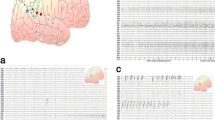Abstract
Posterior reversible encephalopathy syndrome (PRES) is an acute disorder characterised by a variable association of neurologic symptoms with potentially reversible oedematous abnormalities mainly in the parieto-occipital regions of the brain. Despite the significant incidence of seizures, the EEG characteristics of epileptic disorders related to PRES have rarely been investigated. We report the case of an 85-year-old man who presented with generalised tonic-clonic seizures and prolonged disturbances of consciousness as clinical manifestations of PRES due to moderate exacerbation of chronic hypertension. An EEG performed during an alteration of mental function displayed a pattern of partial status epilepticus (SE) in both temporo-parieto-occipital regions. The seizure activity originated from two independent epileptic foci located in the occipital area of each hemisphere and could be related to the parenchymal abnormalities of PRES. The EEG pattern of partial SE related to independent occipital foci illustrates a distinctive seizure disorder that could be characteristic of PRES in adult patients.
Sommario
La sindrome della encefalopatia posteriore reversibile (PRES) è caratterizzata da una associazione di sintomi neurologici acuti (principalmente cefalea, vomito, alterazione della coscienza, crisi epilettiche e cecità corticale) e lesioni edematose potenzialmente reversibili delle regioni cerebrali parieto-occipitali. Descriviamo il caso di un soggetto maschile di 85 anni che ha manifestato crisi tonico-cloniche generalizzate ed un prolungato disturbo della coscienza come manifestazione di PRES secondaria a moderato incremento della pressione arteriosa. L’EEG ha evidenziato uno stato di male epilettico parziale legato a localizzazioni epilettogene occipitali bilaterali ed indipendenti. L’attività epilettica era correlabile alle alterazioni parenchimali della PRES. Il quadro EEGrafico osservato configura un disturbo epilettico raramente descritto nella letteratura, che potrebbe essere caratteristico della PRES in pazienti adulti.
Similar content being viewed by others
References
Lamy C, Oppenheim C, Meder JF, Mas JL (2004) Neuroimaging in posterior reversible encephalopathy syndrome. J Neuroimaging 14:89–96
Hinchey J, Chaves C, Appignani B et al (1996) A reversible posterior leukoencephalopathy syndrome. N Engl J Med 334:494–500
Casey OC, Sampaio RC, Michel E, Truwit CL (2000) Posterior reversible encephalopathy syndrome: utility of fluid-attenuated inversion recovery MR imaging in the detection of cortical and subcortical lesions. Am J Neuroradiol 21:1199–1206
Servillo G, Bifulco F, De Robertis E et al (2007) Posterior reversible encephalopathy syndrome in intensive care medicine. Intensive Care Med 33:230–236
Kozak OS, Wijdicks EFM, Manno EM et al (2007) Status epilepticus as initial manifestation of posterior reversible encephalopathy syndrome. Neurology 69:894–897
Natsume J, Sofue A, Yamada A, Kato K (2006) Electroence-phalographic findings in posterior reversible encephalopathy syndrome associated with immunosuppressants. J Child Neurol 21:620–623
McKinney AM, Short J, Truwit CL et al (2007) Posterior reversible encephalopathy syndrome: incidence of atypical regions of involvement and imaging findings. Am J Roentgenol 189:904–912
Aguglia U, Tinuper P, Farnarier G, Quattrone A (1984) Electroencephalographic and anatomoclinical evidences of posterior cerebral damage in hypertensive encephalopathy. Clin Electroencephalogr 15:53–60
Bakshi R, Bates VE, Mechtler LL et al (1998) Occipital lobe seizures as the major clinical manifestation of reversible posterior leukoencephalopathy syndrome: magnetic resonance imaging findings. Epilepsia 39:295–299
Wennberg RA (1998) Clinical and MRI evidence that occipital lobe seizures can be the major manifestation of the reversible posterior leukoencephalopathy syndrome (RPLS). Epilepsia 39:1381–1383
Author information
Authors and Affiliations
Corresponding author
Rights and permissions
About this article
Cite this article
Rossi, R., Saddi, M.V., Ticca, A. et al. Partial status epilepticus related to independent occipital foci in posterior reversible encephalopathy syndrome (PRES). Neurol Sci 29, 455–458 (2008). https://doi.org/10.1007/s10072-008-1059-2
Received:
Accepted:
Published:
Issue Date:
DOI: https://doi.org/10.1007/s10072-008-1059-2




